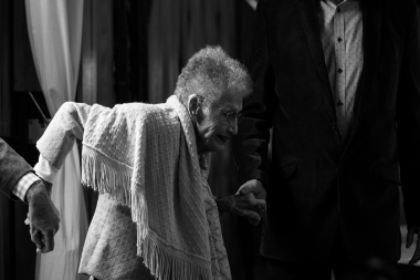
A growing concern in many countries is an aging population and an increase in the number of elderly in need of long-term care. However, the impact of elderly care on the well-being of care providers remains relatively understudied. One of the primary factors which complicate analysis is that a majority of elderly care is provided informally by family members, with adult children often comprising the largest share of care providers. The pervasiveness of unpaid care due to cultural or family ties has even limited the development of long-term care insurance in economically advanced regions like Europe. However, while children may provide an informal safety net, parental caregiving is a time-intensive task and must be met by adjustments in leisure or work hours on the part of the care provider. Hence, in order to understand the full macroeconomic implications of growing elderly care needs and the appropriate policy response, it is imperative to understand how households cope with these caregiving needs.
Economic models of elderly care have focused almost exclusively on inter-generational bargaining between parents and children or bargaining among siblings. However, little attention has been paid to the influence of care demands on the power dynamics between partners within a household (e.g. husband and wife). This is despite data showing that caregiving falls disproportionately on women and that some caregivers respond to increased parental care needs by reducing work hours, taking more flexible jobs, or by quitting paid work entirely. Moreover, caregiving may have spillover effects on the caregiver’s spouse or partner. For example, a spouse may work longer hours or reduce their spending to cope with fewer hours of paid work by the caregiver. So it is unclear to what extent partners reallocate their time and resources and share the burden of parental care needs when they arise.
In the study detailed in the CWE-GAM working series paper published May 2020, we develop a theoretical model to explore how unpaid parental caregiving can affect the allocation of time and resources across partners under different household power structures. As parental caregiving disproportionately falls on daughters, we consider a model in which a woman’s parent is in need of time-intensive care. The provision of care across partners is then a bargained outcome between the couple. We not only examine how power dynamics and work arrangements impact caregivers and their partners but also how these factors may influence unmet care needs and care recipients.
After developing our model, we use cross-country data from the Survey of Health, Age-ing, and Retirement in Europe (SHARE) to illustrate our theoretical concepts with some numerical exercises. Broadly our results indicate caregivers may face a “triple burden” of market work, domestic chores, and caregiving. For example, our model predicts that for a duel-earning couple in France, the total cost of unpaid parental caregiving to the male is only about 57% that of their female partner—a skewed but shared burden. The higher cost to the female stems from two sources; (1) relatively fewer hours of leisure due to her provision of unpaid care; (2) the additional mental or emotional cost of leaving her parent with some level of unmet care needs.
Overall, our theoretical and numerical results show that ignoring bargaining power differentials across partners can misrepresent the true cost of unpaid parental caregiving by not taking into account the uneven distributional consequences. Moreover, our cross-country findings suggest that lower female bargaining power results in a larger burden on female caregivers and additional unmet care needs for their parents. If bargaining power is determined by relative earnings, government policies subsidizing long-term care could decrease the well-being gap within a household by providing financial relief and improving the bargaining position of the caregiver. This could further result in reduced levels of unmet care needs and improved outcomes for elderly care recipients. We further show that inflexible work arrangements also exacerbate the total cost of unpaid caregiving to the household as well as the unequal distribution of the burden. This implies policies that promote flexibility, such as caregiver leave or part-time options, could provide substantial relief, particularly to high-intensity caregivers.
This blog was authored by Ray Miller and Neha Bairoliya, who are both expert researchers for the Care Work and the Economy Project within the Rethinking Macroeconomics working group. To learn more read the CWE-GAM working paper upon which this blog was based here.
